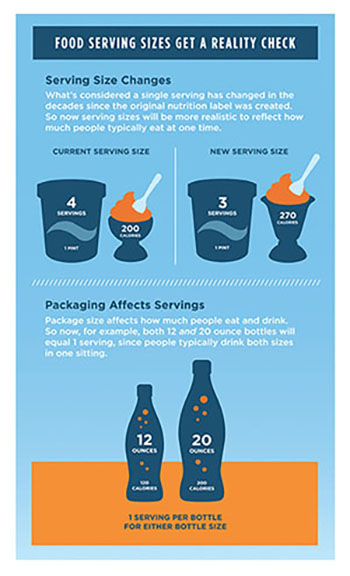Guide E-136
Revised by Cheryl Butterfield
College of Agricultural, Consumer and Environmental Sciences, New Mexico State University
Author: Extension State 4-H Agent, Department of Extension 4-H Youth Development, New Mexico State University. (Print Friendly PDF)
Nutrition labels on processed food were first used in the 1970s to provide consumers with nutrient information. Consumers expect nutritional information on food labels. In May 2016, the Food and Drug Administration (FDA) announced there would be updates to the Nutrition Facts label for packaged foods in order to clarify new scientific information for consumers. These updates were to begin on January 1, 2020, and applied to manufacturers with $10 million or more in annual sales. Manufacturers with less than $10 million in annual food sales will have until January 1, 2021, to incorporate the new labels. The following information is meant to help consumers understand various aspects of nutritional information on food labels.
What’s new with the new Nutrition Facts label (Figure 1) starting January 2020
- Servings sizes are listed in larger and bolder type and have been updated to reflect the amounts people are actually eating or drinking.
- Calories are in a larger and bolder type.
- Calories from fat are no longer included due to research that shows the type of fat consumed is more important than the amount.
- Added sugars (in grams and % Daily Value) are now required.
- Required nutrients have been updated to include vitamin D, potassium, iron, and calcium. The actual amount as well as the % Daily Value must be listed for each of these nutrients.
- Footnote has changed to better explain the meaning of % Daily Value intake (DVI).

Figure 1. New-and-improved nutrition facts label (Food and Drug Administration, 2020).
The Nutrition Facts label is intended to provide consumers with useful information when making food selections. Let’s look at how you would use the Nutrition Facts label in your decision-making.
1. Servings
- Servings per container indicates the total number of servings in the packaged item.
- There may be more than one serving of food in a package. Package size affects the amount that people eat or drink (Figure 2).
- Serving size tells the consumer the nutritional information based on one serving of the packaged food. This is now listed in larger, bolder type. When assessing calories and nutrients between different foods, make sure the serving size in grams, milliliters, or ounces is the same in order to make a correct comparison.

Figure 2. Serving sizes have been updated to reflect the serving amounts that people are actually consuming. (Food and Drug Administration, 2021.)
2. Calories
- This is now in larger and bolder type. To maintain a healthy weight, the number of calories taken in (eaten) needs to be balanced by the number of calories expended (body uses, such as everyday activity and exercise).
- Calories represents the total number of calories or “energy” contained in one serving of the packaged food from all sources (including fats, carbohydrates, proteins, and alcohol).
- General guide:
- 40 calories per serving is considered low
- 100 calories per serving is considered moderate
- 400 calories per serving is considered high
- An adult consuming 2,000 calories per day is used as a guide. However, your caloric needs may be higher or lower depending on factors such as age, gender, height, weight, and activity level.
See the Choose MyPlate website (https://www.choosemyplate.gov/) to check your caloric needs.
3. Total fat
- Total fat is listed as well as the type of fat (saturated fat and unsaturated fat). Research shows that saturated fat is less healthy than unsaturated fat. Aim to eat less saturated fat.
4. Added sugars
- Consumers are now able to see added sugars listed on the Nutrition Facts label.
- “Added sugars include sugars that are added during the processing of foods (such as sucrose or dextrose), foods packaged as sweeteners (such as table sugar), sugars from syrups and honey, and sugars from concentrated fruit or vegetable juices” (Food and Drug Administration, 2020).
- Consumers should try to consume less than 10% of their total daily calories from added sugars.
5. Nutrients
- Updated to include vitamin D and potassium due to Americans not getting the recommended amount of these nutrients. However, vitamins A and C are no longer required to be included on the label since deficiencies of these vitamins are rare today.
- Use the label as a guide to choose products to meet the nutrient needs according to the recommended daily value.
- “Daily values are reference amounts of nutrients to consume or not to exceed and are used to calculate the percent Daily Value (% DV) that manufacturers include on the label” (Food and Drug Administration, 2021).
- Cholesterol, sodium, and carbohydrates are nutrients that Americans tend to eat in sufficient amounts. Eating too much fat, saturated fat, trans fat, cholesterol, or sodium may increase your risk of certain chronic diseases, like heart disease, some cancers, or high blood pressure. Visit https://www.fda.gov/food/food-labeling-nutrition/changes-nutrition-facts-label for more information. Limit these nutrients according to individual dietary needs.
6. Footnote
- Use the footnote to help understand the percent Daily Values (% DV).
- Ingredient list: The ingredient list is not part of the Nutrition Facts label panel; however, it can be very useful in making healthy choices. The ingredients are listed in descending order by weight. Therefore, the ingredient that weighs the most is listed first, while the ingredient that weighs the least is listed last.
Sources
Food and Drug Administration. 2020, March 11. What’s new with the Nutrition Facts label [Online]. Available at https://www.fda.gov/food/new-nutrition-facts-label/whats-new-nutrition-facts-label
Food and Drug Administration. 2021, February 10. Changes to the Nutrition Facts label [Online]. Available at https://www.fda.gov/food/food-labeling-nutrition/changes-nutrition-facts-label
For Further Reading
E-113: Nutrition Facts for Better Meals
https://pubs.nmsu.edu/_e/E113/
E-118: Storing Food Safely
https://pubs.nmsu.edu//_e/E118/
E-139: MyPlate—The Vegetable Group: Vary Your Veggies
https://pubs.nmsu.edu//_e/E139/

Cheryl Butterfield is the State 4-H Agent of Volunteer and Leadership Development at NMSU’s State 4-H Office. She earned her B.S. and M.S. from NMSU. Her Extension work focuses on working with the State 4-H Leadership Team, youth leadership events, and 4-H volunteers.
To find more resources for your business, home, or family, visit the College of Agricultural, Consumer and Environmental Sciences on the World Wide Web at pubs.nmsu.edu.
Contents of publications may be freely reproduced, with an appropriate citation, for educational purposes. All other rights reserved. For permission to use publications for other purposes, contact pubs@nmsu.edu or the authors listed on the publication.
New Mexico State University is an equal opportunity/affirmative action employer and educator. NMSU and the U.S. Department of Agriculture cooperating.
Revised October 2021 Las Cruces, NM


